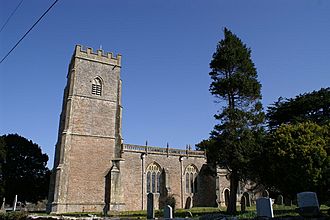Church of St Leonard, Rodney Stoke facts for kids
Quick facts for kids Church of St Leonard |
|
|---|---|
 |
|
| General information | |
| Town or city | Rodney Stoke |
| Country | England |
| Coordinates | 51°14′42″N 2°44′29″W / 51.2449°N 2.7414°W |
| Completed | c. 1175 |
The Church of St Leonard is a very old church located in Rodney Stoke, a village in Somerset, England. It was built a long time ago, around the year 1175. This church is considered a very important historical building. It has a special status called a Grade I listed building. This means it is one of the most important historic buildings in England.
Contents
Inside the Church of St Leonard
The inside of the church has many interesting features. One special item is a beautiful wooden screen. This screen was given to the church in 1624. It was a gift from a person named Sir Edward Rodney. The screen shows a picture of St Erasmus. He was an important saint from early Christian times.
Victorian Changes to the Church
In the 1870s, the church had some big changes. This period was known as the Victorian restoration. During this time, many old churches were repaired and updated. They wanted to make them look good and work better. As part of these updates, a special stove was put into the church floor. This stove helped to keep the building warm.
How the Church is Organized Locally
The Church of St Leonard is part of a larger group of churches. It is linked with the church in Draycott. This group is called a benefice. It helps the churches work together. This benefice is also part of a bigger area called the Axbridge deanery. This is how the church is organized within its local region.
Important People Buried Here
Many people who were important to the local area are buried at the Church of St Leonard.
- Sir Edward Rodney (1590–1657)
- Anne Rodney (1599–1630)
- Frances Rodney (d. 1659)
More to Explore
- Grade I listed buildings in Mendip
- List of ecclesiastical parishes in the Diocese of Bath and Wells
- List of Somerset towers

